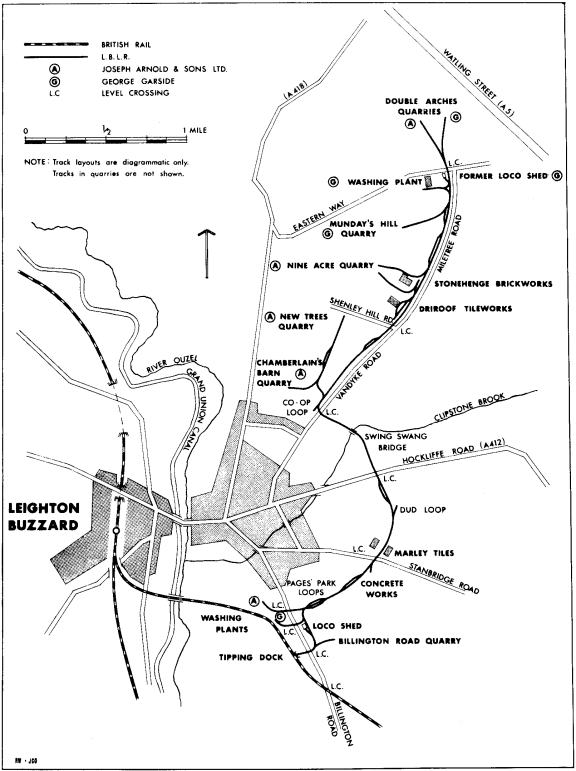
| THE INDUSTRIAL RAILWAY RECORD |
© MARCH 1966 |
LEIGHTON BUZZARD
LIGHT RAILWAY
“MUCH OBLIGED”
"Despite the difficulties of the times, the work of constructing the Leighton Buzzard Light Railway has been steadily continued throughout the last few months, and on Thursday afternoon the formal opening took place. In a few days more, it is hoped, waggons laden with sand will be travelling along the line, and the long procession of road vehicles which have done so much damage to the roads near Leighton Buzzard will almost cease to exist."
So runs the first paragraph of an article in the "Leighton Buzzard Observer" which announced the opening of the line on 20th November 1919. The railway was the idea of Joseph Arnold & Sons Limited who, with George Garside (another quarry owner), arranged for the formation of an operating company - the Leighton Buzzard Light Railway Limited. Thus in 1919, two small Hudswell Clarke 0−6−0 well tank engines began to run on what is now one of the better-known narrow gauge, diesel operated, industrial railways in the country. The steam locos did not last for many years, being replaced by standard "Simplex" four-wheeled petrol locos when traffic increased. In later years, these were converted for running on T.V.O. (Tractor Vapourising Oil) before finally being scrapped in 1959. However, in the early 1950’s the first of five diesel locos appeared, still of "Simplex" design, and these proved most economical.
Today, the condition of some sections of the track leaves much to be desired although traffic runs without much trouble. Occasionally, wagons leave the rails due to bad joints or excessive speed, but more often because of faults in their wheels and axles. Loco derailments are less frequent, a spare loco with jacks and lifting tackle being sent to the rescue in these cases. The section between "Double Arches" and "Munday’s Hill" is the worst, but this is only to be expected, as by far the greatest amount of traffic uses this section. At the time of writing Arnold’s are running about five trains and Garside’s one train daily between "Double Arches" and Billington Road. In addition to this Arnold’s have a small loco taking sand from "Double Arches" to Stonehenge Brickworks and Driroof Tiles about one mile away. Sometimes sand is taken from "Nine Acre Quarry" (once Chance’s Quarry) to the plant at "Double Arches" depending on requirements. Garside’s also have two or three locos taking sand from "Munday’s Hill" to "Double Arches". Sand is also conveyed to Stonehenge Brickworks from "Chamberlain’s Barn" but this rarely runs to more than four trains a week, usually less.
The track is laid to 2ft gauge using 30lb rail (20lb on the lines in the quarries). The large locos haul twenty-four wagons, being classified as 40 h.p. The smaller 20 h.p. locos haul up to fourteen wagons. At one time Arnold’s used to have five trips to Billington Road, each trip consisting of up to five trains. Thus there was a maximum of twenty-five trains per day and rather less for Garside’s. This was before the days of the lorry however. Arnold’s also used to run two locos to Stonehenge Brickworks but this is catered for by one loco now. There also used to be a busy service from "Double Arches" to Marley Tiles, near Stanbridge Road, of up to 140 wagons per day, but this is now collected by lorry. The system of work to be introduced when "New Trees Quarry" is opened remains to be seen but I do not think that the 40 h.p. locos will work there from "Chamberlains Barn" as the new line is constructed with 20lb rail.

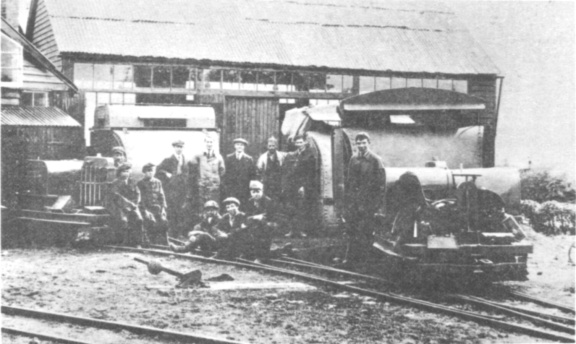
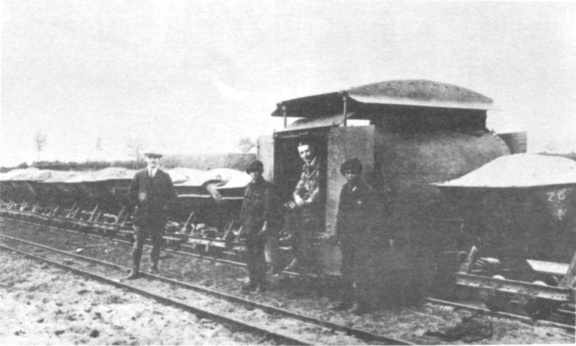
Two
views of the railway soon after it was opened.
The locomotives are ex-War Department six ton "Simplex" type.
(Author's collection)
The wagons used are standard Hudson tippers, each holding about 23cwts of sand when heaped full. Thus a train of twenty-four wagons can easily weigh fifty tons including the weight of the wagons and a six ton loco. There are also eight Hudson bogie wagons with sides, used by Arnold’s for carrying dried sand in bags. They are loaded with up to six tons of sand and are always shunted on to the front of the train. They are classed as being ‘equal to four" loaded sand wagons, which allows for their general tendency to ‘hold back’ a loco, probably due to the springs on the buffers. It should be mentioned here that, whereas the ordinary wagons are coupled by simple pins and links, these bogies are always coupled with ‘treble links’ as otherwise the buffers lock when the bogies are being pushed by a loco.
Another interesting point is that there are two sizes of wagon wheels in use on the system. Garside’s use all small wheeled wagons which are generally said to be very troublesome; they certainly seem to have more derailments than Arnold’s who use much larger wheels on all wagons travelling through to Billington Road, but they too use small wheeled wagons on the Stonehenge Brickworks trains and throughout most of the quarries, together with large wheels on certain quarry trains. The general ‘rule of the road’ is that empty trains must give way to loaded trains although if a loaded train is barely past a loop, the driver will usually set back.
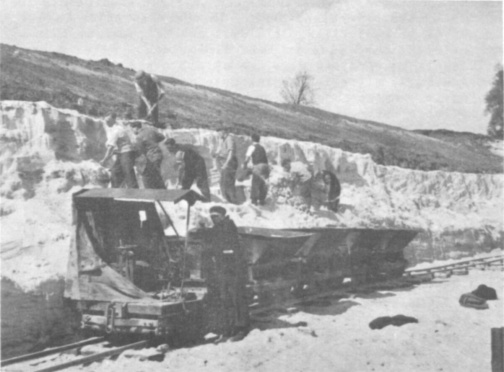
A scene at the Double Arches Pits of Joseph Arnold & Sons Ltd.
Locomotive 23 (Motor Rail 7128) at the working face on 8th April 1964.
(G. H. Starmer)
In the heavy snows of 1962-1963 the railway was impassable for some time but eventually, with some shovel work and help from a snowplough, the line was cleared. Arnold’s trains ran with a loco at each end and Garside’s with two engines pulling. Some of the snow was piled so high beside the line that with the force from the exhaust pipes blowing the snow about, the locos sometimes finished their journey with snow inside the cabs and plastered over the mainframes. On one day in particular, an Arnold’s train left "Double Arches" at 10.30a.m. but soon got stuck. A gang worked hard with shovels against a high wind and the locos eventually struggled through to Billington Road at 4.30p.m.!
The line is some four to five miles in length and a train usually takes thirty to forty minutes for the complete journey, which includes crossing five public roads on the level. On leaving "Double Arches" a Garside’s train will cross the Clipstone Brook by a small timber bridge before joining Arnold’s track and immediately crossing Eastern Way. Here there is a man on crossing duty all day to flag the train across the road owing to the number of quarry locos that run without engine mates. After crossing Eastern Way, Garside’s old loco shed, now used for storing spare locos and for repairs, and a disused tipping dock are passed on the right. On the left, Miletree Road runs parallel to the line for about two miles, changing its name to Vandyke Road further along. After a short stretch of up and down, "Munday’s Hill Quarry" is passed on a rising gradient to the right. Immediately afterwards there is a pair of right-hand points at the top of Munday’s Hill, from which there is a very steep descent, particularly the upper section, as far as Stonehenge Brickworks. The pair of points mentioned above forms the entry to a long loop that runs the length of the steepest part. This loop is now virtually disused and overgrown with grass but in days gone by, two track running was the order up and down the gradient. At the brickworks a pair of right-hand points leads to the sand tip and there is another loop here. Immediately after this a line goes off to the right to Driroof Tiles. (It will now be apparent that all passing loops are on the right hand side in this direction.) After a gradual rise, Shenley Hill Road is reached and here, as at all other public road crossings, the trains must stop to allow the engine mate to flag the train over the road before rejoining it. After about another half-mile, in which there is another passing loop, a large curve to the left is reached known as the "Co−op Loop". Here the branch to "Chamberlain’s Barn Quarry" (and "New Trees Quarry") leaves the main line. There is also a short siding here which was once a passing loop judging by the name of the curve. Next the line crosses Vandyke Road and descends along the side of a field, soon to have a school built on it, to cross the Clipstone Brook again by a stone bridge with the curious nick-name of the "Swing-Swang". The line now rises again and after a very tight right-hand curve (that could not possibly have been so sharp when the steam locos were running), a short run across another field brings it to Hockliffe Road. After crossing the road there is another loop and beyond this, a short dead-end siding running into a field. This stops any runaways from crossing the busy Hockliffe Road. The points are spring-loaded and must be held closed when an empty train runs through. After rounding a right-hand curve, a formidable climb faces loaded trains. This is a quarter-mile bank which runs as far as Stanbridge Road passing loop. On this hill there is an occupation crossing between the Marley Tiles depots on either side of the line. This is where the locomotive exhaust whistles are needed. After getting about half way up, all trains stop to split into two portions; although the locos could probably pull right up on a dry rail it is considered wiser not to strain the engines. The wagons are left in the Stanbridge Road loop, the loco returning for the other half of the train. It is on this hill that any weak couplings are discovered, for wagons have been known to run back and form "a nice little pickle". The sidings into Marley Tiles used to leave the main line near the passing loop here, but these are now all removed. After crossing Stanbridge Road, the Leighton Buzzard Concrete Works, on the left-hand side, are served by a pair of facing points. Arnold’s, who supply a few wagons of sand each day, push the wagons in here after the loco has taken them from the back on the train at Hockliffe Road loop and pushes them up the hill. This is done so far away because otherwise, after splitting the train on the hill, the concrete works’ wagons would be in the middle of the train. After passing the concrete works the line passes under a recently constructed footbridge for the use of the R.A.F. personnel at a nearby camp. The line now rises as far as the next loop (now lifted), after which there is a gradual downhill run to Pages Park loop near Billington Road. Here the Garside’s loco runs round the train, another loco couples on in its place and the train runs across the road into Garside’s plant area, thus leaving the large loco at the right end for returning with the empties. Arnold’s loco will first uncouple and go across the road to the washing plant, pulling out, with another loco, washed sand and take it to the British Rail tipping dock. The two engines will then take the unwashed sand down to the plant, the large engine again being at the right end for the return journey. The run with the empties back to "Double Arches" usually takes about twenty-five minutes.
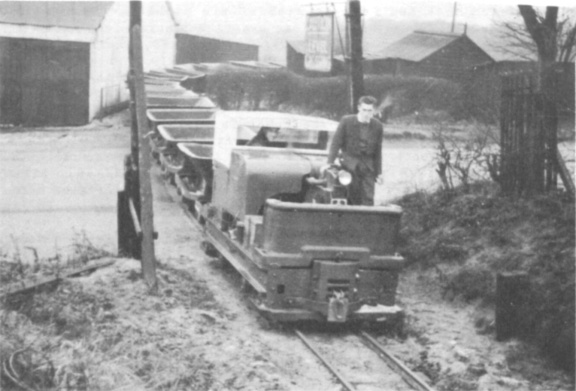
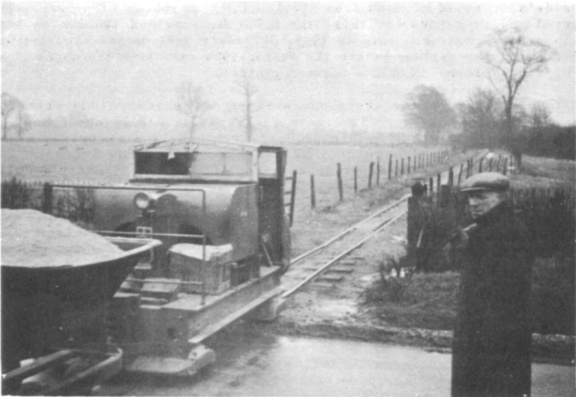
Two typical scenes on the line in recent
years, showing the
smaller type locomotives which superseded the WD pattern.
(Author)
By December 1958, it was evident that the railway was rapidly becoming uneconomic and could not continue as it was. As a result, the L.B.L.R. sold their remaining six diesel locos (four to Arnold’s and two to Garside’s), the remaining T.V.O. locos being scrapped. From then until the end of 1963 all trains were manned by the labour from their respective firms (i.e. Arnold’s or Garside’s) instead of that from the L.B.L.R. A system of prices per wagon was agreed and in return for this, the L.B.L.R. provided two men to keep the track in order. However, late in 1963, Garside’s gave notice that they wished to cease using the railway before the end of 1964 and, with the approval of the L.B.L.R. shareholders, Arnold’s assumed control.
POSTSCRIPT. Since the above was written in February 1964 considerable changes have occurred. Garside’s have replaced their Billington Road drying plant with a new one near "Double Arches", reached by a steeply graded line from a sharply curved triangular junction about 150 yards from the Eastern Way level crossing. Some six or seven wagons (from both "Munday’s Hill" and "Double Arches") are pushed up at a time to the tipping hopper.
Arnold’s have also dismantled their washing plant at Billington Road and built a new one at "Double Arches" to deal with the sand from "New Trees Quarry". Only washed sand is now conveyed to Billington Road and about sixty to eighty wagons a day are sent down to be tipped into British Rail wagons. "New Trees Quarry" is worked by two 20 h.p. locos, shedded at "Chamberlain’s Barn", which pull out sixteen wagons a time (one loco at each end) as far as the Co−op loop. From here a 40 h.p. loco hauls the load to "Double Arches" and then returns with a load of washed sand. At the Co−op loop a second loco, which has brought empties from Billington Road for "New Trees", will be waiting to take the wagons on to Billington Road; the first loco then returns to "Double Arches" with another load from "New Trees". During the day therefore one loco works the lower half and another the upper half of the line; in the evening both return to Billington Road. Since the opening of "New Trees Quarry" sand is no longer taken from "Nine Acre" to "Double Arches" as this was only a temporary arrangement whilst a certain seam of sand was being worked.
Garside’s ceased to use the L.B.L.R. early in 1965 but, as Arnold’s only constructed the branch from "Chamberlain’s Barn" to "New Trees" in 1963, there seems to be a good chance that this little railway will still be here to celebrate its Golden Jubilee in 1969.